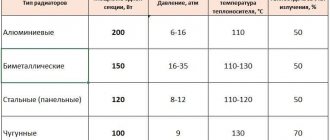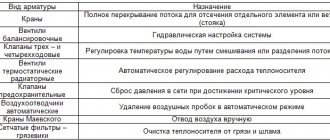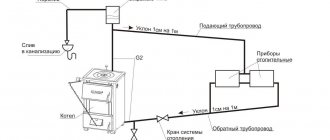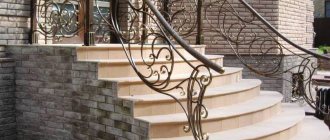When arranging a private home, sooner or later the question of choosing a heating system scheme arises. Today there are so many of them that an inexperienced person can get confused and choose the wrong thing. Installers often recommend what is profitable for them to install. But since you came to this page, choosing a system in your home will be much easier. First, we will share the main varieties, and at the very end we will share our opinion and choice of heating scheme for the house.
The main principle of heating operation
Any type of heating system is closed. In a simple version, any wiring diagram can be considered as a ring consisting of pipes. It circulates hot liquid from the heating boiler to the heating devices, remaining in them for some time. The coolant releases thermal energy during circulation and is again directed inside the boiler for heating. The cycle repeats periodically.
Any heating scheme includes:
- Heating boiler
- Connecting system pipes
- Radiators or similar heating devices
- Armature
- Expansion tank
- Circulation pump
Which home heating system to choose
There are several types of heating systems. They differ in pipe layout, methods of connecting radiators and how the coolant moves through them. Competently choosing the most effective option is possible only if you have knowledge of heating engineering. It is necessary to make complex calculations and prepare a project. For a small cottage, a simple one-pipe scheme is quite suitable. In other cases, it is better to delegate the design to a professional. But the installation work can be done independently.
Basic types of heating schemes
All types of schemes can be divided into 4 subtypes: open and closed, pump and gravity.
In the gravity system of a private house (system with natural circulation), the movement of coolant occurs through natural circulation. By following simple laws of physics, the system is installed in such a way that it does not require an additional pump. Well suited for small one-story houses
In the forced water heating scheme of a private house, liquid occurs due to the action of the circulation pump. When using such a system, pipes can be mounted in walls, in the floor, along the ceiling, and hidden from human eyes. With the correct selection of the pump, water heating will work successfully. Such wiring schemes are great for two-story houses.
An open system differs from a closed system by an expansion tank. A closed system uses a membrane tank. It allows you to maintain the required pressure in the system and compensates for the expansion of the coolant.
Now let's look at each scheme in more detail.
Recommendations for the selection and installation of pipes
To install the heating of a private house with your own hands, you first need to decide which pipes to choose for this. The modern market offers several types of metal and polymer pipes suitable for heating private homes:
- steel;
- copper;
- stainless steel;
- polypropylene (PPR);
- polyethylene (PEX, PE-RT);
- metal-plastic.
Heating lines made of ordinary “ferrous” metal are considered a relic of the past, since they are most susceptible to corrosion and “overgrowth” of the flow area. In addition, it is not easy to independently install such pipes: you need good welding skills to make a hermetically sealed joint. However, some homeowners still use steel pipes to this day when they install autonomous heating at home.
Copper or stainless steel pipes are an excellent choice, but they are too expensive. These are reliable and durable materials that are not afraid of high pressure and temperature, so if you have the means, these products are definitely recommended for use. Copper is joined by soldering, which also requires some skills, and stainless steel is joined using dismountable or press fittings. Preference should be given to the latter, especially when the installation is hidden.
Advice. For piping boilers and laying pipelines within the boiler room, it is best to use any type of metal pipes.
Heating made from polypropylene will cost you the cheapest. Of all types of PPR pipes, you need to choose those that are reinforced with aluminum foil or fiberglass. The low price of the material is their only advantage, since installing heating from polypropylene pipes is quite a complex and responsible task. And in appearance, polypropylene is inferior to other plastic products.
The joints of PPR pipelines with fittings are made by soldering, and it is not possible to check their quality. When the heating was insufficient during soldering, the connection will certainly leak later, but if it is overheated, the melted polymer will half block the flow area. Moreover, you won’t be able to see this during assembly; flaws will make themselves known later, during operation. The second significant drawback is the large elongation of the material during heating. To avoid “saber” bends, the pipe must be mounted on movable supports, and a gap must be left between the ends of the line and the wall.
Recommendation. Do not embed polypropylene products into floor screeds or wall strobes. This is especially true for pipe joints.
It is much easier to make your own heating from polyethylene or metal-plastic pipes. Although the price of these materials is higher than polypropylene. For a beginner, they are the most convenient, since the joints here are made quite simply. Pipelines can be laid in a screed or wall, but with one condition: connections must be made using press fittings, not collapsible ones.
Metal-plastic and polyethylene are used both for open laying of highways and hidden behind any screens, as well as for the installation of water-heated floors. The disadvantage of PEX pipes is that it tends to return to its original state, which can cause the installed heating manifold to appear slightly wavy. PE-RT polyethylene and metal-plastic do not have such a “memory” and easily bend as you need. More information about choosing pipes is described in the video:
Gravity heating system, advantages and disadvantages
In this type of heating system for a private house, hot water, heated inside the boiler (usually solid fuel), moves upward, after which it ends up in the heating radiators. From them, heat goes into the room and is again sent to the return pipeline. From it it already goes into the heating boiler. The constant movement of heated water is ensured by the necessary inclination of the supply (direct) pipeline and return, as well as the use of pipes of different diameters. For the supply from the boiler, pipes of a smaller diameter are used, and for the return, the pipeline in which water is directed to the boiler, a larger one.
The gravity-flow wiring diagram for the water heating system of a private house has a specific device in the form of an open expansion tank connected to the outside space, mounted at the top of the pipeline. The tank is intended to take part of the water when it is heated, since this process is accompanied by an increase in the volume of coolant. An expansion tank filled with water creates the hydraulic pressure in the heating system necessary for fluid movement.
As water cools, its volume decreases. Some of the liquid from the open tank again enters the pipeline system. This ensures the necessary continuity of water flow circulation.
A gravity heating system has the following advantages:
- Uniform distribution of thermal energy
- Sustained action
- Autonomy from power grids
A gravity heating system also has disadvantages:
- Difficult installation. The slope angle of the pipelines must be observed
- Significant length of pipes
- The need to use pipes of different sizes
- Inertial system. It reduces the degree of control of the heating process
- The need to heat water to a relatively high temperature, which limits the use of polypropylene materials for pipes
- Significant volume of pipeline
- Inability to connect “warm floors”
Selection by power and methods of connecting radiators
The number of sections or the size of a panel radiator is selected based on the amount of heat required to heat the room. We have already determined this value at the very beginning; it remains to reveal a couple of nuances. The fact is that the manufacturer indicates the heat transfer of the section for a temperature difference between the coolant and the air in the room equal to 70 °C. To do this, the water in the battery must warm up to at least 90 ° C, which happens very rarely.
It turns out that the real thermal power of the device will be significantly lower than that indicated in the passport, because usually the temperature in the boiler is maintained at 60-70 ° C on the coldest days. Accordingly, for proper heating of the premises, the installation of radiators with at least one and a half heat transfer margin is required. For example, when a room needs 2 kW of heat, you must take heating devices with a capacity of at least 2 x 1.5 = 3 kW.
Indoors, batteries are placed in places of greatest heat loss - under windows or near blank external walls. In this case, connection to highways can be done in several ways:
- lateral one-sided;
- diagonal scalene;
- lower - if the radiator has appropriate pipes.
The lateral connection of the device on one side is most often used when connecting it to risers, and the diagonal connection to horizontally laid highways. These 2 methods allow you to effectively use the entire surface of the battery, which will heat evenly.
When a single-pipe heating system is installed, the lower versatile connection is also used. But then the efficiency of the device decreases, and hence the heat transfer. The difference in surface heating is illustrated in the figure:
There are models of radiators where the design provides for connection of pipes from below. Such devices have internal wiring and, in fact, they have a one-sided side circuit. This can be clearly seen in the figure, where the battery is shown in section.
A lot of useful information on the issue of choosing heating devices can be found by watching the video:
Single-pipe heating circuit
As a rule, this system wiring diagram is used in private one-story houses and is characterized by easy installation, low labor costs and low cost. Radiators are connected to the heating pipe in series. There is no provision for waste coolant removal. This water heating scheme has many disadvantages when heating a private house:
- loss of thermal energy - each subsequent heating device will heat up less than the previous one;
- the inability to regulate the heating intensity in one room without similar consequences for the rest. By reducing the temperature in one of the radiators, all subsequent radiators will inevitably cool down;
- the need to additionally equip the heating system with a pump to maintain operating pressure in it.
There are technological methods that can be used to partially get rid of these problems. You can improve the operation of a single-pipe wiring diagram using special equipment: thermostatic valves, radiator regulators, air vents, balancing valves. Their use will slightly increase the cost of installation, but will allow the temperature in one of the radiators to be lowered or lowered without undesirable temperature changes in the remaining heating devices.
Recommendations for choosing and connecting radiators
An ordinary homeowner, going to a heating equipment store and seeing a wide selection of different radiators there, can conclude that choosing batteries for his home is not so easy. But this is the first impression; in fact, there are not so many varieties of them:
- aluminum;
- bimetallic;
- steel panel and tubular;
- cast iron
Note. There are also designer water heating devices of a wide variety of types, but they are expensive and deserve a separate detailed description.
Sectional batteries made of aluminum alloy have the best heat transfer rates; bimetallic heaters are not far behind them. The difference between the two is that the former are made entirely of alloy, while the latter have a tubular steel frame inside. This was done for the purpose of using the devices in centralized heat supply systems of high-rise buildings, where the pressure can be quite high. Therefore, installing bimetallic radiators in a private cottage makes no sense at all.
It should be noted that heating installation in a private home will be cheaper if you purchase steel panel radiators. Yes, their heat transfer rates are lower than those of aluminum ones, but in practice you are unlikely to feel the difference. As for reliability and durability, the devices will successfully serve you for at least 20 years, or even more. In turn, tubular batteries are much more expensive, in this respect they are closer to designer ones.
Steel and aluminum heating devices have one useful quality in common: they lend themselves well to automatic control using thermostatic valves. The same cannot be said about massive cast iron batteries, on which it is pointless to install such valves. This is due to the ability of cast iron to heat up for a long time and then retain heat for some time. Also because of this, the rate of heating of the premises is reduced.
If we touch on the issue of appearance aesthetics, then the cast-iron retro radiators currently offered are much more beautiful than any other batteries. But they also cost incredible amounts of money, and inexpensive Soviet-style accordions MS-140 are only suitable for a one-story country house. From the above, the conclusion suggests itself:
For a private home, buy those heating devices that you like best and are comfortable with in terms of cost. Just take into account their features and choose the right size and thermal power.
Two-pipe heating circuit
This water heating system is widely used in houses of any number of floors. Its peculiarity is that water is supplied to the radiator through one pipe, and drained through another. The heat exchangers are connected to the heating system not in series, but in parallel.
Main advantages:
- coolant with the same temperature is supplied to each radiator;
- it becomes possible to install a thermostat on radiators to set the desired temperature in each individual room;
- disconnection or malfunction of one of the batteries will not affect the operation of the others.
The system has a number of disadvantages. Its installation requires a large number of pipes and connecting elements, which leads to an increased degree of complexity of installation work and a higher cost of the entire water heating system.
What warms us
Situations when you have to install a heating system may be different. Construction of a private house, transition from a stove to a more modern method of heat supply, heating of an already constructed building. Perhaps you wanted to do as much as possible without outside help and do the heating yourself.
Either way, the first step is choosing the type of heating for your home. Simply put, you need to decide what will heat you: water, air, steam, electricity?
Almost any scheme is based on the movement of a substance (coolant), which, when heated, releases heat into the atmosphere and heats the room. The center of the heating system is the boiler. Models are available that run on liquid, solid fuel, gas, or from the mains.
Boilers vary in power, type of fuel and, accordingly, cost. In addition, they are distinguished by work functions. Some are for heating only, others also provide hot water.
Heating scheme with heated floors
Heated floors provide horizontal thermal radiation, maintaining a higher temperature at foot level and reducing it to a comfortable level at higher altitudes. In areas with warm climates, the circuit can be used as the only source of heat. In northern latitudes it must be combined with the installation of a radiator heating system.
Structurally, the underfloor heating system is a network of pipelines. Heating can be done from any heat sources.
System advantages:
- uniform distribution of heat throughout the entire volume of the room;
- improving the aesthetic appearance of the room due to the absence of pipes and radiators.
Recommendations for choosing a boiler
At the moment, there are various types of heating, characterized by the energy carrier or type of fuel used. Which one to choose is up to you, and we will present all types of boilers with a brief description of their pros and cons. To heat residential buildings, you can purchase the following types of household heat generators:
- solid fuel;
- gas;
- electrical;
- on liquid fuel.
The following video will help you choose an energy carrier, and then a heat source:
Gravity system "Spider"
The vertical heating circuit of a private house with a top spill without the use of a circulation pump is called “Spider”. The main advantage is complete autonomy from gas or electricity, which is especially in demand in rural areas or in holiday villages. In the circuit, the coolant moves due to the temperature difference at the inlet and outlet of the heating device. In the absence of gas and electricity, it is best to use a solid fuel boiler.
The operating principle of the “Spider” is based on the laws of physics - hot water rushes upward, displacing cold water downward. As a result of heating, the water rises from the boiler along the riser to the radiator, gives it part of its thermal energy and moves to the next one until it returns back to the boiler. The functioning of the system depends on the accurate selection of pipes and compliance with slopes. Water intake must be carried out above the level of the heat exchangers. The boiler should be located lower. The main disadvantage of the scheme can be considered quite complex installation work .
Scheme "Leningradka"
“Leningradka” is one of the simplest, but nevertheless quite effective and economical heating schemes for wiring a private house. It is similar to a single-pipe scheme, that is, the coolant sequentially passes through all the radiators of the room, gradually losing its heating temperature. The main pipe is placed along the floor and loops the circuit from the heating device. It is best to use Leningradka in one-story houses so that all batteries are on the same level. In this case, the system can operate with natural circulation, but when installing it in two-story houses, it is necessary to use a forced supply of coolant.
The advantages of this scheme are:
- economical consumption of materials;
- easy installation;
- long-term reliable operation;
- the ability to hide the main pipe under the floor covering to improve the aesthetics of the interior.
Leningradka" is not without significant drawbacks:
- inability to maintain the same temperature in all rooms;
- horizontal wiring does not allow connecting heated floors or heated towel rails;
- a large area of the room requires the use of a circulation pump to ensure operating pressure in the system.
Boiler connection
It should be noted that the wiring of gas, diesel and electric heat generators is almost the same. Here we must take into account that the vast majority of wall-mounted boilers are equipped with a built-in circulation pump, and many models are equipped with an expansion tank. First, let's look at the connection diagram for a simple gas or diesel unit:
The figure shows a diagram of a closed system with a membrane expansion tank and forced circulation. This tying method is the most common. The pump with a bypass line and a sump tank is located on the return line, and there is also an expansion tank there. The pressure is controlled using pressure gauges, and air is removed from the boiler circuit through an automatic air vent.
Note. Piping an electric boiler that is not equipped with a pump is carried out according to the same principle.
When the heat generator is equipped with its own pump, as well as a circuit for heating water for domestic hot water needs, the pipe layout and installation of elements is as follows:
Shown here is a wall-mounted boiler with forced air injection into a closed combustion chamber. To remove flue gases, a double-walled coaxial flue is used, which is led out horizontally through the wall. If the firebox of the unit is open, then you need a traditional chimney with good natural draft. How to properly install a chimney pipe made of sandwich modules is shown in the figure:
In country houses with a large area, it is often necessary to connect a boiler with several heating circuits - a radiator, heated floors and an indirect heating boiler for DHW needs. In such a situation, the optimal solution would be to use a hydraulic separator. It will allow you to organize independent circulation of coolant in the boiler circuit and at the same time serve as a distribution comb for the remaining branches. Then the basic heating diagram for a two-story house will look like this:
According to this scheme, each heating circuit has its own pump, thanks to which it operates independently of the others. Since coolant with a temperature of no more than 45 ° C should be supplied to heated floors, three-way valves are used on these branches. They add hot water from the main line when the temperature of the coolant in the heated floor circuits drops.
With solid fuel heat generators the situation is more complicated. Their strapping should take into account 2 points:
- possible overheating due to the inertia of the unit; the firewood cannot be extinguished quickly;
- formation of condensation when cold water enters the boiler tank from the network.
To avoid overheating and possible boiling, the circulation pump is always placed on the return side, and on the supply side there should be a safety group located immediately behind the heat generator. It consists of three elements: a pressure gauge, an automatic air vent and a safety valve. The presence of the latter is crucial; it is the valve that will relieve excess pressure when the coolant overheats. If you decide to heat your house with wood, then the following wiring diagram is required:
Here, a bypass and a three-way valve protect the furnace of the unit from condensation. The valve will not allow water from the system into the small circuit until the temperature in it reaches 55 °C. Detailed information on this issue can be obtained by watching the video:
Advice. Due to the nature of their operation, solid fuel boilers are recommended to be used in conjunction with a buffer tank - a heat accumulator, as shown in the diagram:
Many homeowners install two different heat sources in the furnace room. They must be properly tied and connected to the system. For this case, we offer 2 schemes, one of them is for a solid fuel and an electric boiler working together with radiator heating.
The second scheme combines a gas and wood heat generator, supplying heat to heat the house and prepare water for hot water supply:
Radiant heating scheme
The radial water heating wiring diagram is newfangled. When using it, hot water is evenly distributed throughout the room through the collector. The degree of heating of the home is regulated by changing the heating of the water and the speed of its movement through the pipes.
It is an improved version of the two-pipe circuit. To distribute the coolant, the same collector is used as in a warm field.
The main advantages of the beam wiring scheme include:
- Jointlessness. There are no joints inside the screed. The likelihood of leakage is significantly reduced
- The ability to turn off each device individually on the collector without harming the entire system
The only drawback is the price. Due to the use of a collector and an additional number of pipes, the price of the system also increases.
Beam system with collectors
Radiant heating system using a collector.
This is one of the most modern schemes, which involves laying an individual line to each heating device . To do this, collectors are installed in the system - one collector is the supply, and the other is the return. Separate straight pipes diverge from the collectors to the batteries. This scheme allows for flexible adjustment of heating system parameters. It also makes it possible to connect heated floors to the system.
The radial wiring diagram is actively used in modern homes. The supply and return pipes here can be laid in any way - most often they go in the floors, after which they are suitable for one or another heating device. To regulate the temperature and turn on/off heating appliances, small distribution cabinets are installed in the house.
According to heating engineers, this scheme is ideal, since each heating device operates from its own mains and is almost independent of other heating devices.
Advantages and disadvantages of beam systems
There are many positive qualities:
- the ability to completely hide all pipes in the walls and floors;
- convenient system setup;
- possibility of creating remote separate adjustment;
- minimum number of connections - they are grouped in distribution cabinets;
- it is convenient to repair individual elements without interrupting the operation of the entire system;
- almost perfect heat distribution.
When installing a radiant heating system, all pipes are hidden in the floor, and the collectors are hidden in a special cabinet.
There are also a couple of disadvantages:
- high cost of the system - this includes the costs of equipment and installation costs;
- difficulty in implementing the scheme in an already built house - usually this scheme is laid out at the stage of creating a home ownership project .
If you still have to put up with the first drawback, then there is no escape from the second.
Features of installation of radiant heating systems
At the project creation stage, niches are provided for laying heating pipes, and installation points for distribution cabinets are indicated. At a certain stage of construction, pipes are laid, cabinets with collectors are installed, heating devices and boilers are installed, a test run of the system is carried out and it is checked for leaks. It is best to entrust all this work to professionals, since this scheme is the most complex.
Despite its complexity, a radiant heating system with collectors is one of the most convenient and efficient. It is used not only in private homes, but also in other buildings, for example, in offices.











